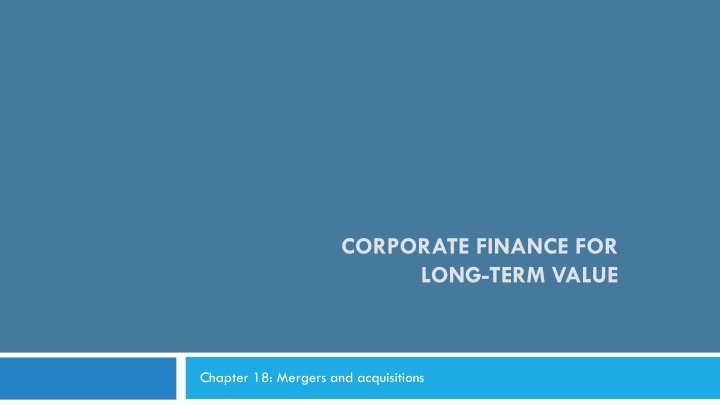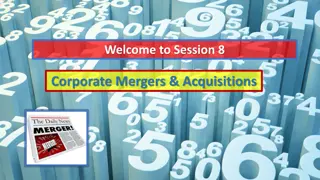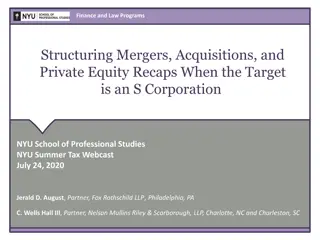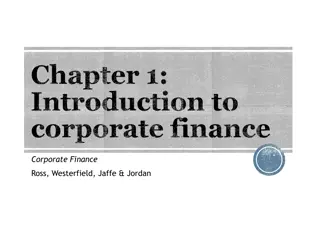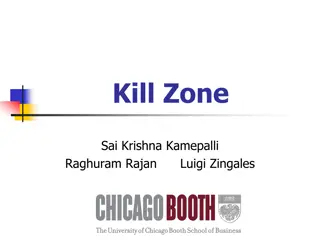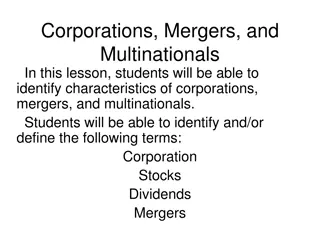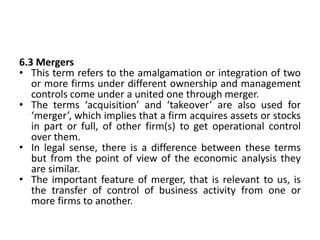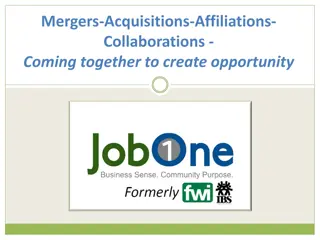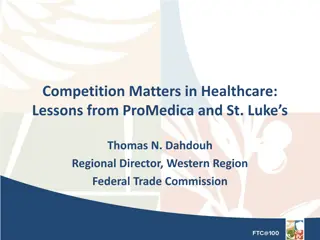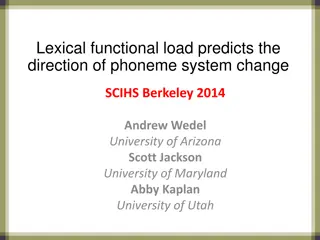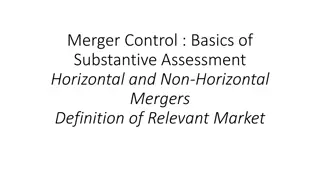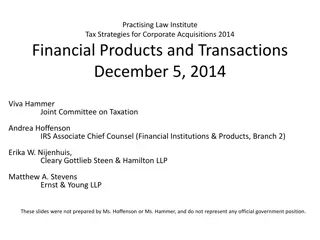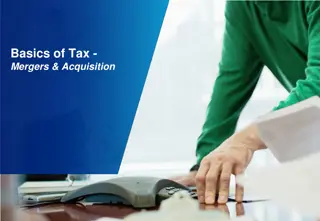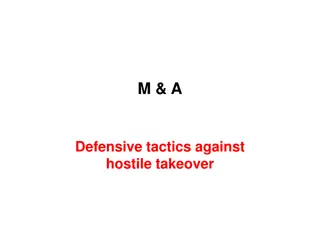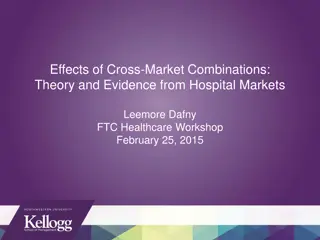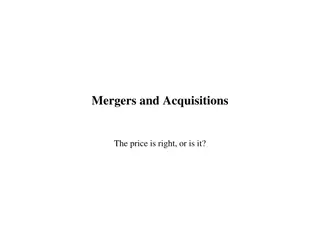Overview of Mergers and Acquisitions in Corporate Finance
Mergers and acquisitions (M&A) involve one company taking over or merging with another, with value creation achievable through synergies. The buying company is the bidder/acquirer, while the selling company is the target/acquired. M&A deals can be friendly or hostile and involve extensive due diligence. Regulators may intervene if deals are deemed anti-competitive. Understanding the financial, behavioral, and environmental/social (E&S) aspects is crucial for successful M&A activity.
Download Presentation

Please find below an Image/Link to download the presentation.
The content on the website is provided AS IS for your information and personal use only. It may not be sold, licensed, or shared on other websites without obtaining consent from the author.If you encounter any issues during the download, it is possible that the publisher has removed the file from their server.
You are allowed to download the files provided on this website for personal or commercial use, subject to the condition that they are used lawfully. All files are the property of their respective owners.
The content on the website is provided AS IS for your information and personal use only. It may not be sold, licensed, or shared on other websites without obtaining consent from the author.
E N D
Presentation Transcript
CORPORATE FINANCE FOR LONG-TERM VALUE Chapter 18: Mergers and acquisitions
Part 5: Corporate financial policies Chapter 18: Mergers and acquisitions
The BIG Picture 3 M&As are very large investments in which a company takes over another company Discussion Value creation is more likely if there are synergies between the companies involved There are many dubious motives for M&As Financial sanity of M&A activity can be assessed with the NPV method Large numbers and big stakes in M&A make behavioural issues more problematic If not properly understood and considered, E and S issues can reduce the company s financial value An integrated perspective on M&A valuation is needed -> integrated value method
Mergers and acquisitions 4 In a takeover or acquisition, one company buys another company and it is typically quite clear who is the buyer and who is the seller In a merger, it is supposed that companies of roughly equal size together decide to continue as one company, without a clear buyer or seller Sometimes a deal may be called a merger for political reasons, whereas it is quite clear who is the senior party and who the junior The buyer is called the bidder during the bidding process and called the acquirer if the deal happens The company that is sold, is called the target during bidding and becomes the acquired company once the deal is done
Bidding process 5 A bidding process takes months and is preceded by screening activities aimed at identifying the most suitable targets and doing initial valuations Due diligence is carried out in which the bidder scrutinises the target s accounts under strict non-disclosure agreements Bids can be friendly (with consent of target management) or hostile (lacking consent) A deal can be stopped by regulators if it is deemed to be anti-competitive or contrary to national interests Example: in August 2020, the UK government blocked the takeover of electronic design company Pulsic by a Hong Kong rival over national security concern
M&A types 6 The market s assessment of a potential M&A transaction is expressed in the stock price reactions of the target and the bidder, which reflects: The value creation for shareholders The likelihood that the transaction will happen M&As can be classified in terms of business activity: Horizontal same line of business Vertical different parts of the same value chain Conglomerate unrelated business
Motives for M&A 7 M&A deals can be done for several reasons, some deemed more valid than others The search for synergies is typically deemed a valid reason Cheap funding and increased earnings per share (EPS) are seen as poor reasons Synergies mean that the cooperation of two organisations provides better results than the sum of their parts There are several sources of synergies: Economies of scale: as production volumes go up, costs tend to fall Economies of scope: combining similar products could lead to spill-over effects Vertical integration: acquiring other parts of the value chain can improve streamlining Industry consolidation: reducing competition means a larger part of consumer surplus is taken Transition: acquiring companies with advanced E and/or S capabilities can accelerate transition
Poor reasons for M&A deals 8 Poor reasons for M&A deals can be behaviourally driven: Escalation of commitment: if much time and efforts has already been invested, it often becomes difficult to stop a process When operating in the domain of losses: negative results may lead to overvaluation of takeovers Overoptimistic managers: overconfident CEOs overestimate their ability to generate returns, thereby overpaying for target companies and undertaking value-destroying mergers Serial acquisition: some companies are serial acquirers and acquire multiple companies per year, with performance declining deal by deal
M&A advisory 9 During an M&A process, both the bidder (acquirer) and the seller (target) hire advisory partners, also known as buy-side and sell-side mandates Typically, an investment bank acts as the primary contact person for the sellers and bidders throughout the entire process Each selling or bidding company hires its own investment bank advisor Various specialists are hired to conduct a due diligence of the target Financial experts normalise and evaluate the target s earnings and financial statement Operational specialists evaluate the different value drivers of the target Lawyers review critical company contracts and prepare non-disclosure agreements and purchase agreement
M&A waves 10 M&A activity comes in waves and are linked to the state of the economy During an upswing, M&A activity increases During a downturn, M&A activity declines Global M&A Deals between 1980-2021 Number of M&A Deals (in thousands) 80 7,000 Total Deal Value (in $ billion) Global Financial Crisis of 2008 Internet bubble bursting in early 2000s 6,000 60 5,000 4,000 40 3,000 2,000 20 1,000 0 0 1980 1985 1990 1995 2000 Year 2005 2010 2015 2020 Number of M&A Deals Deal Value
M&A valuation 11 Koller, Goedhart and Wessels (2020) define the M&A value creation as follows: Standalone value of the target Manager s assessment (does not need to equal market value) Value received Value of performance improvements The measures that acquirer intends to take (i.e. cost-cutting, using new market channels) Value created for the acquirer Market value of the target Price paid Price paid by acquirer on top of market value of target (driven by expectations and behaviour) Acquisition premium
M&A valuation example 12 Value, $ millions at 20% takeover premium Value, $ millions at 30% takeover premium Value component Standalone intrinsic value of the target 650 650 Synergies are estimated at 15% of intrinsic value + Value of performance improvements 97.5 97.5 = Value received (1) 747.5 747.5 Market value of the target 585 585 10% undervaluation of company s intrinsic value Seller demands 20% premium (left) or 30% premium (right) on top of target s market value + Acquisition premium 117 175.5 = Price paid (2) 702 760.5 Value is created for acquirer with 20% premium Value is destroyed for acquirer with 30% premium Value created for acquirer (1) - (2) 45.5 -13
Financing M&A deals 13 The acquiring company can pay price for target company in cash, in stock or both price paid = market value of the target + acquisition premium Cash financed M&A deal: acquirer offers original share price plus acquisition premium to target s shareholders Many deals are (partly) paid in acquirer s stock, with stockholders receiving a fraction ? of combined companies: ??? ? ???? ??? + ??? ? ???? ? = In a stock offer, effective price of merger or takeover is affected by M&A gains or losses Payment in stock mitigates undervaluation and overvaluation of both companies In overvaluation, target and acquirer stockholders share in the losses In undervaluation, target and acquirer stockholders share in the gains
Behavioural issues in M&A valuation 14 Behavioural issues can be internal or external errors Internal errors: managers overvalue their own company, the target or the synergies Before companies make their bid, they can overestimate synergies or underestimate risks In a bidding context, management can succumb to the winner s curse: winning by overpaying External errors: the market overvalues the target or the bidder Shleifer and Vishny (2003) assume that acquirers are overvalued and the motive of acquisitions is to preserve some overvaluation for long-runs shareholders Market-level mispricing proxies and merger volume are positively correlated
Hedge fund activism 15 Activist hedge funds specialise in hostile M&A activity, and have a highly concentrated portfolio of holdings in companies that they want to shake up Boyson, Gantchev and Shivdasani (2017) find that shareholder value creation from hedge fund activism occurs primarily by influencing takeover outcomes for targeted firms Even failed bids lead to improvements in operating performance, financial policy, and positive long-term abnormal returns at targets of activism, which suggests that activism enhances value Brav, Jiang, Ma and Tian (2018) find that companies targeted by activists improve their innovation efficiency over the five-year period following hedge fund intervention
E and S effects on M&A before valuation 16 Managers can see E and S issues as drivers of risks and opportunities in their product markets Risks: certain assets can be considered too risky operationally or to be bringing reputation risks Opportunities: driving strategic preferences (i.e. sustainability skills, renewable energy assets) Companies can become targets because of their sustainability skills Companies with higher CSR scores are more likely to be acquisition targets High CSR acquirers take less time to complete and are less likely to fail than mergers by low CSR acquirers Stronger CSR profile of the bidder means higher probability of closing the deal High carbon emitting acquirers are more likely to buy firms in countries with low GDP
E and S effects on M&A valuation 17 E and S can affect the value drivers and hence the attractiveness of M&A deals Also important to do E and S due diligence (see Monsanto take-over below) Research finds a positive link between targets overall CSR (and environmental) performance and acquisition premiums High CSR acquirers realise higher merger announcement returns, compared with low CSR acquirers E and S can also have impact on post-deal performance: Compared with low CSR acquirers, high CSR acquirers realise larger increases in post- merger long-term operating performance
Monsanto takeover 18 The underestimation of E and S effects can be extremely costly importance of E and S due diligence Bayer, the German pharma and biotechnology company, announced the takeover of the agrichemical company Monsanto in 2016 The final cash offer amounted to $63 billion Soon after finishing the deal, the first lawsuits on Monsanto s Roundup weed killer started, internalising the negative health issues A chemical ingredient of Roundup is glyphosate, which was shown by a 2015 WHO report to cause cancer in animals as well as damaging effects on human cells Monsanto has settled over 100,000 Roundup lawsuits worth over $10 billion; over 30,000 lawsuits are still pending Bayer cut its dividend to zero in 2021 after litigation on health issues hit 2020 cash flows and profits
E and S driven M&A activism 19 The past years have seen the emergence of sustainability-driven activism by hedge funds Jana Partners pressured Apple to address the potential negative effects of iPhone use on children Trian Partners has pushed companies to promote workplace diversity, adopt supplier codes of conduct, and reduce emissions and waste Some hedge funds went further, and put companies under pressure to do E and S driven M&A deals Bluebell asked Glencore to separate its coal mines Third Point called for a breakup of Shell DesJardine and Durand (2020) found that hedge fund activism between 2000-2016 yielded benefits that were: Shareholder-centric and short-lived With immediate increases in market value and profitability Coming at a mid- to long-term cost to other stakeholders Captured by decreases in operating cash flow, investment spending, and social performance
E and S valuation of M&A 20 Market power is becoming an important source of value, reducing consumer surplus Incumbent firms may acquire innovative targets solely to discontinue the target s innovation projects and pre-empt future competition (called killer acquisitions ) Acquired drug projects are less likely to be developed when they overlap with the acquirer s existing product portfolio To determine the E and S valuation effects of M&A, one needs to calculate: The pre-deal EV and SV of the target and the bidder EV and SV of the resulting combination
E and S valuation of M&A 21 SV valuation in M&A In this example, ??+, ?? , and ?? Bidder, pre-deal Target, pre-deal Synergies Total deteriorate as a result of the deal ??+ 14 23 -3 34 Likely because the bidder imposes ?? -27 -3 -12 -42 its exploitative business model and -13 20 -8 -15 ?? lower standards on the target EV valuation in M&A The loss of SV and EV in synergies Bidder, pre-deal Target, pre-deal Synergies Total is substantial: ??+ 0 0 0 0 -15 on SV (top table) ?? -52 -18 -7 -77 -52 -18 -77 -7 ?? -7 on EV (bottom table)
Integrated M&A valuation 22 Top table shows the IV for a low-quality bidder Bidder Target Synergies Total 126 38 171 7 ?? The financial synergies (7) are offset by the negative ??+ 14 23 34 -3 social (-15) and environmental (-7) synergies, resulting ?? -27 -3 -42 -12 ?? -52 61 -18 40 -77 86 -7 -15 in overall negative synergies (-15) ?? Bottom table shows the IV for a high-quality bidder Bidder 108 79 -5 -25 157 Target 38 23 -3 -18 40 Synergies 3 4 1 7 15 Total 149 106 -7 -36 212 Financial synergies are lower (3), but the high E&S ?? ??+ quality bidder also realises positive social (5) and ?? environmental (7) synergies ?? The high-quality bidder manages to improve the overall ?? value creation profile of the combined company by 15
Kraft Heinz Unilever case 23 Kraft Heinz attempted a takeover of Unilever in 2017 Kraft Heinz s strategy was to maximise shareholder value, measured by EPS (earnings per share) Using EPS multiples, Kraft Heinz estimated the financial value of the synergies to be 46 billion (left column) An IPV analysis of the synergies based on a DCF model showed a value destruction of 63 billion (right column) Conclusion: the estimated synergies depend very much on how the valuation analysis is conducted Two main reasons for the differences: IPV analysis based on DCF Financial analysis based on EPS IPV analysis includes not just financial value but all three value dimensions Value Synergies Value Synergies FV 46 FV -11 Financial analysis was based on EPS maximisation strategy (achieving sales growth while cutting costs) while IPV analysis was based on DCF valuation (long-term fundamental value) SV -38 EV -13 FV 46 IPV -63
IPV criterion 24 As long as ??? ?? ?? > 0 is the main criterion to judge the soundness of an M&A deal, the change in SV and EV is more likely to be negative than positive Applying the IPV criterion (below) to M&A deals can improve the value profile of the company across the three value dimensions ??? = ?? + ? ?? + ? ?? > 0 The incidence of M&A deals that do improve SV and/or EV is likely to increase with: SV and EV being measured or at least seen Lower discount rates on SV and EV Higher values for the parameters b and c to weight SV and EV
Integrated takeover test 25 The aftermath of the aborted takeover of Unilever by Kraft Heinz generated a debate on the protection of companies steering on integrated value Without protection, financial considerations (F) would always dominate social and environmental considerations (S+E) De Adelhart Toorop, De Groot Ruiz and Schoenmaker (2017) propose a integrated value test for takeovers: It is the responsibility of the management of both the acquiring and target company to conduct this test to obtain the integrated value of the joint companies An independent advisor would give a fairness opinion on the outcome of the integrated takeover test
DSMs transition through M&As 26 When the coal mines were closed in the 1970s, the Dutch government helped the transformation of DSM (Dutch State Mines) into a base chemicals company Since the 1990s, DSM has transformed itself again, becoming a global science- based company for nutrition and health through a string of M&A deals The DSM Firmenich merger combines the health and nutrition divisions of DSM and the taste and perfume divisions of Firmenich This merger completed the transition of DSM into a global leader in nutrition, beauty and wellbeing
Integrated view on M&A activism 27 M&A activism is typically justified by claims of value creation, but the key question is whether that value creation benefits all stakeholders (FV, SV and EV all rise) It would be helpful if this distinction would already be made by managers, analysts, regulators, and reporters Improving FV, SV, and/or EV without hurting the other Taking a share of value at the expense of FV, SV, and/or EV Value creation Value extraction
Conclusions 28 M&A are very large investments in which a company absorbs another company, which can dramatically change the profile of a company s assets Value creation is often more likely if there are synergies between the companies involved Large numbers and big stakes in M&A make behavioural issues more problematic If not properly understood and considered, E and S issues can reduce the company s financial value (illustrated by Bayer s acquisition of Monsanto) An integrated perspective on M&A valuation is needed For large M&A deals, an integrated value test should be required
